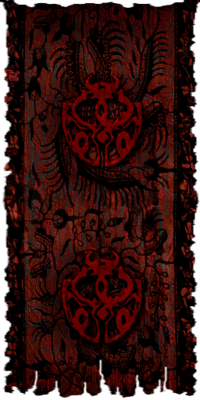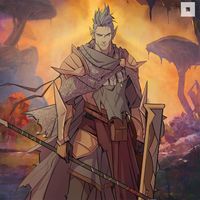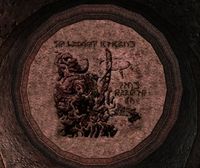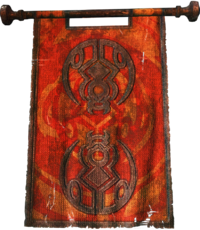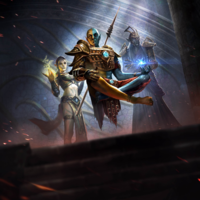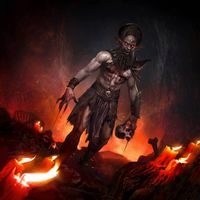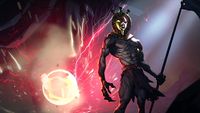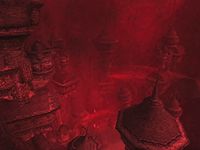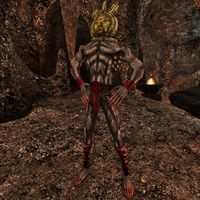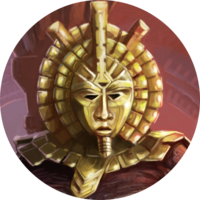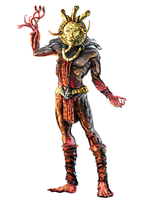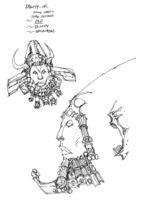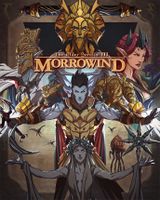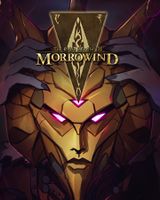Lore:Dagoth Ur
This article is about the god. For the mountain, see Red Mountain. For the building, see Dagoth-Ur (place).
- "What a fool you are. I'm a god. How can you kill a god? What a grand and intoxicating innocence. How could you be so naive? There is no escape. No Recall or Intervention can work in this place. Come. Lay down your weapons. It is not too late for my mercy." — Dagoth Ur
| Lord High Councilor Dagoth Ur | |||
|---|---|---|---|
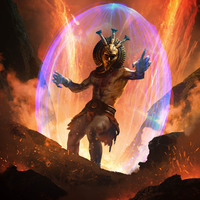 Lord High Councilor Dagoth Ur
Lord High Councilor Dagoth Ur |
|||
| Race | Dunmer/Ash Creature (formerly Chimer) | Gender | Male |
| Born | 1st Era |
||
| Died | 3E 427 Red Mountain |
||
| Resided in | Red Mountain Kogoruhn |
||
| Appears in | Morrowind, Legends | ||
Dagoth Ur, also known as Voryn Dagoth,[1] the Sharmat,[2][3] as well as Awakened Lord of the Sixth House,[4] Lord Dagoth and Father of the Mountain to his followers,[5] was the immortal Lord High Councilor of House Dagoth. In Tribunal mythology, he is demonized as the Devil and the Enemy, False Dreamer,[3] Devil Dagoth Ur,[5] and Devil of Dagoth.[6]
In the First Era, he inadvertently caused the Battle of Red Mountain by informing the Hortator Indoril Nerevar that House Dagoth had discovered the Dwemer's worship of a secret source of power, the Heart of Lorkhan, which the Chimer deemed profane and heretical.[7] Accounts vary significantly on what actions he took before, during, and after the battle, but regardless, it resulted in Dagoth and the Sixth House being defeated and condemned as traitors, their names being largely erased from Dunmeri history by the Tribunal Temple.[8]
Unbeknownst to the Tribunal, Dagoth and the Sixth House were not completely wiped out, and he and his kin slept beneath Red Mountain for millennia.[9] He would awaken in the late Second Era, creating plans to build a second Numidium named Akulakhan to conquer Tamriel.[9] He wreaked havoc on Morrowind for centuries by robbing the Tribunal of their source of divine power[9] and creating legions of Corprus monsters by unleashing the Blight.[10] His reign of terror would end in the late Third Era when the Nerevarine ventured into Red Mountain and defeated him.[11]
History[edit]
Early Life[edit]
Voryn Dagoth was the Chimer Lord High Councilor of House Dagoth[12] one of the seven Great Houses of Resdayn which ruled the land alongside their allies the Dwemer. He resided in Kogoruhn (Unbroken Home in Dark Elvish) the clanstead of the House.[13] The rulers of the First Council were Nerevar the Hortator of the Chimer, and Dumac Dwarf-Orc the King of the Dwemer.[7][14] Voryn was a trusted friend of both rulers,[7] particularly Nerevar who he was of the same generation as,[12] and shared a brotherly bond with.[1] He also served Nerevar loyally as his general.[15] He was a mighty sorcerer and enchanter.[12]
The War of the First Council[edit]
Loyal Dagoth Ur[edit]
Voryn Dagoth played a heavy role in the divide of and eventual war among the First Council, although accounts greatly differ on what side he was on. Certain stories, namely that of both the Ashlanders and Vivec himself tell a similar tale that differ in key aspects.
These accounts involve Lord Dagoth approaching Nerevar and his advisors, Almalexia, Sotha Sil, and Vivec with knowledge that House Dagoth had discovered the source of the long unknown secret power source the Dwemer worshipped, that of the legendary Heart of Lorkhan. Dagoth explained that the Dwemer had used this profane power to make themselves immortal and thus beyond the measure of the gods, and that the High Priest, and Chief Tonal Architect of the Dwemer Kagrenac the Blighter even had gone as far as to devise tools to build a New God that served as a mockery of Chimer faith and a fearsome weapon that the Dwemer would use to claim Resdayn for their own.[7][14]
Nerevar was troubled by this and approached Dumac with these accusations and asked if they were true. Kagrenac and his priests had kept the construction of the New God, Numidium, a secret from the king and thus Dumac claimed innocence for his people of any wrongdoing. Kagrenac approached Nerevar and asked him who he thought he was to presume to judge the actions of the Dwemer. Nerevar was no less troubled by this meeting with the Dwemer, so now made pilgrimage to Holamayan, the sacred temple of the Daedric Prince Azura, who confirmed that everything Dagoth had said was true, and that the construction of this New God should be prevented at all cost for not only the sake of Resdayn, but for the whole world.[7][14]
Nerevar, angered that Dumac seemingly lied to him, returned to Red Mountain one final time arrayed in arms and armor and surrounded by his hosts, he hoped to preserve the peace, but demanded to Dumac and his people that they give up their worship of the Heart of Lorkhan. Dumac was still unaware of the plans of the New God, but was proud and protective of his people and the two quarreled bitterly and thus went to war.[7][14]
The War of the First Council concluded at the Battle of Red Mountain. According to the aforementioned accounts, by the combined cleverness of the Tribunal and Nerevar, the Dwemer armies were largely drawn out of their fortress of Red Mountain into the open fields, which allowed Nerevar, Dagoth, and a small group of companions the opportunity to sneak into the Heart Chamber by secret means. There, the two kings Nerevar and Dumac met and both fell from grievous wounds and draining magics.[7][14] The similar accounts disagree on exactly what happen next at this point.
Vivec's retelling says that with his king down, and threatened by Voryn Dagoth and others, Kagrenac turned his tools upon the Heart, and at that moment all Dwemer in the world disappeared without a trace.[7] The Ashlander account instead claims that before Kagrenac could use his tools, he was slain by Lord Dagoth who presented them to his dying friend Nerevar and asked him what to do with the tools. Nerevar summoned Azura and the Daedric Prince showed them how to use the tools to separate the power of the Heart from the Dwemer people, and the Tribunal and their armies then bore witness to all of the Dwarves turn into dust with their stolen immortality taken away.[14] Regardless, the accounts continue on that Dagoth bade to Nerevar that the tools of Kagrenac be destroyed, so as to avoid future evils should the tools fall in the wrong hands. But Nerevar was confused by his wounds and sorrow for the loss of his old friend Dumac and the Dwemer whom he still loved, and also did not wish to ignore the Tribunal's council yet again and thus went to confer with them, leaving his general and friend Voryn Dagoth with the words "Stay here, loyal Dagoth Ur, until I return."[7][14]
Accounts once again disagree on what happened from this point forward, a gravely injured Nerevar went to receive council from the Tribunal. According to the Ashlanders, the Tribunal decided that the Chimer should attempt to harness this power for themselves so Nerevar might claim Resdayn and the very world for their people. Nerevar did not expect or want that and so asked his queen and generals to summon Azura yet again for her guidance. The Tribunal who had become greedy and coveted the Heart betrayed Nerevar. They feigned the ritual to summon Azura but used poisoned candles, poisoned robes, and poisoned invocations, killing the Hortator.[14]
Azura appeared before them and vowed to use her powers over dusk and dawn to make sure Nerevar would come back and make things right again. Azura before departing then placed a curse upon the Tribunal and the Chimer people as a whole turning their skin ashen and their eyes into fire, the Chimer had become the Dark Elves, the Dunmer. The Tribunal then returned to the Heart Chamber and met with Dagoth-Ur, who saw what had been done, for his skin had changed as well. He tried to avenge the death of Nerevar but was defeated by the Tribunal who thought him dead. The Tribunal found the tools Dagoth had been guarding and, through study of Kagrenac's methods, turned themselves into gods.[14]
Vivec's account of the council, and subsequent actions of himself and his fellow Tribunes greatly differs. His claim is that the Tribunal advised that the tools be preserved and studied for the welfare of the Chimer and as a precautionary in the event the Dwemer should ever return. Nerevar voiced grave misgivings but agreed to the council under one condition. That all of them swear oaths under Azura that the tools would never be put to use in the profane manner that the Dwemer had intended. Everyone readily agreed and swore the solemn oaths at Nerevar's dictation.[7]
Upon returning to Red Mountain, Nerevar and the Tribunal found Dagoth Ur unwilling to yield the tools to them, saying that only he could be trusted with them and that they were dangerous: Dagoth had seemingly learned the power of the tools in the period of time he was left alone with them. Nerevar and his guard resorted to taking the tools by force. Somehow Dagoth Ur and his retainers escaped, but the tools were retrieved and put within the care of Sotha Sil for safekeeping. For some years the Tribunal kept the oaths they swore with Nerevar before Azura, but in secret, Sotha Sil had been studying the tools and managed to divine their mysteries. He approached his fellow Tribunes with a vision of peace, prosperity, and a better world. They then made the pilgrimage to Red Mountain and used the tools upon the Heart to transform themselves, and instantly Azura appeared before them, vowing that Nerevar would return to punish them for their perfidy, subsequently cursing them by turning their skin ashen and their eyes of fire, the Chimer into Dunmer.[7]
Devil of Dagoth[edit]
Other accounts of the War of the First Council and ultimate conclusion at the Battle of Red Mountain go in a much different direction in regards to Dagoth Ur. Whereas the aforementioned accounts have him staying loyal to his fellow Chimer and his liege Nerevar and fighting against the Dwemer at their side, some say otherwise.
According to the Nordic legends of the Five Songs of King Wulfharth the Nords upon learning that the Dwarves and Devils (Chimer) of the eastern kingdoms had started to fight again, the Nords hoped they might be able to reclaim their ancient holdings because of it. They made plans for attack but quickly gave up after realizing they had no strong King to lead them. But suddenly Voryn Dagoth, who the Nords referred to as the Devil of Dagoth arrived swearing peace, and claiming he knew where the Heart of Shor was. Dagoth informed the Nords that the Devils and Dwarves had the heart of Shor but the Nords grew suspicious asking why he would betray his countrymer in such a manner to which the Devil of Dagoth responded that his people have betrayed one another since the beginning of time, and this was so and so the Nords believed him.[6]
The Tongues sung Shor's ghost again and Shor gathered an army as he did of old, and then he sucked in the long-strewn ashes of King Wulfharth and remade him, for he needed a good general. But the Devil of Dagoth petitioned to be that general too, and pointed out his role as the blessed harbinger of the holy war, thus Shor had two generals, the Ash King Wulfharth and the Devil of Dagoth. And they marched on to the eastern kingdoms with all the sons of Skyrim.[6]
The next song of King Wulfharth claims that the Devil of Dagoth had tricked the Nords, the Heart of Shor was not in the eastern kingdoms and never had been, as soon as Shor and his army arrived to Red Mountain, the Devils and Dwarves fell upon them. Their sorcerers lifted the mountain and threw it onto Shor, trapping him under Red Mountain for all of time. The Nord army was slaughtered but not before Wulfharth managed to kill Dumalacath the Dwark king and doom his people. Vehk the Devil then blasted the Ash King into Hell but Kyne lifted him from Hell and showed the color of blood when it is brought by betrayal, and the Nords vowed to never trust another Devil again.[6]
A subsequent secret song titled "The Truth at Red Mountain" claims that the Heart of Shor was indeed in Resdayn as Dagoth Ur had promised. Dagoth Ur admitted that the Tribunal had betrayed Nerevar's trust and had sent him to Lorkhan (for that is what they called Shor in Resdayn) so that the god might wreak vengeance on the Dwemer for their hubris, as they believed Nerevar's peace with the Dwemer would bring ruin to the Velothi way. Lorkhan vowed that for his own reasons the Dwemer would indeed die by his hand.[6]
Lorkhan claimed Nerevar the son of Boethiah, one of the strongest Padomaics and recognized him as a hero to his people despite his treacherous Tribunal and said he would muster enough that the battle ahead would be hard going. And so Dagoth-Ur, who wanted the Dwemer as dead as the Tribunal did, went to Kogoran and summoned his House chap'thil, his nix-hounds his wizards, archers, his stolen men of brass. And the Ash King Wulfharth went and made peace with the Orcs in spite of his Nordic blood, and they brought many warriors but no wizards at all.[6]
At the last Battle of Red Mountain, Lorkhan, Dagoth Ur, and Wulfharth confronted Nerevar who wielded Keening, Dumac who wielded Sunder and Alandro Sul the immortal son of Azura who wielded the Wraith Mail. Lorkhan had reunited with his Heart, but he had long been from it and needed time to gain his full strength. Wulfharth and Sul dueled but Wulfharth was unable to strike him, he fell from grievous wounds but not before shouting Sul blind. Dumac was able to strike Lorkhan's Heart with Sunder but was subsequently slain by Dagoth Ur. Nerevar turned away from Lorkhan and struck down Dagoth Ur in a rage but was then left open to receive a mortal wound from Lorkhan. But Nerevar feigned the death that was coming early and struck Lorkhan with surprise on his side. The Heart had been made solid by Dumac's earlier tuning blow with Sunder and because of this Nerevar was able to cut it out with Keening, dealing Lorkhan a second death and the whole thing was thought over.[6]
The Traitor House[edit]
While the Ashlander, Nordic, and Vivec's account feature Dagoth Ur and his allies as enemies of the Dwemer, several others sources claim the opposite.
As the story goes, religious disputes were formed between the secular Great Houses of the First Council, House Dwemer and House Dagoth and the orthodox Houses Indoril, Dres, Hlaalu, Telvanni, and Redoran.[16][17][18] The basis of the disputes was about the sorceries and enchantments practiced by the Dwemer and declared profane by the other houses.[17] The alliance with House Dagoth came naturally as by some accounts House Dagoth had taken to practicing some of the rituals and principles pioneered by High Craftlord Kagrenac, with Dagoth Ur himself adopting the views and motivations of Kagrenac.[9] They also found themselves aligned with western allies in the Nords and Orcs who were drawn in from the promises of land and booty.[17][16]
House Dagoth, House Dwemer and the others held northwest Resdayn and delivered the widely dispersed and poorly organized Orthodox Houses defeat after defeat until Nerevar was made undisputed general of all House troops and levies.[18] Nerevar also secured aid of the nomadic Ashlanders who proved to be vital as scouts in a major battle on Vvardenfell in which the Secular forces were outmaneuvered and defeated and the survivors were forced to flee to Dwemer stronghold of Red Mountain.[18][17]
After a brief siege, an act of treachery allowed Nerevar and his troops to enter the fortress.[17] The Secular were defeated with great slaughter, Dagoth Ur managed to deal a mortal wound to Nerevar,[19] but thereafter terrible sorceries were used that resulted in the utter extermination of the Dwemer, House Dagoth, and their allies.[18] Nerevar died shortly after the battle to his wounds but lived long enough to see the birth of the Temple and bless the unity of the Dunmer into the safekeeping of Almsivi, the Temple, and all its communion of saints.[19][16] The Ashlanders on the other hand say one of his final acts was promising to honor the Ancient Spirits and the Tribal Law and that he will come again to honor that promise.[20]
Sharmat[edit]
Vivec has alternative accounting of the battle in his Sermons.
He claims that the Dwemer and Chimer lived under the wise and benevolent rule of Almsivi and their champion the Hortator but the Dwemer became foolish and challenged their masters. The Nords and Ysmir Wulfharth came to the aid of the Dwemer, who were led by King Dumac and High Priest Kagrenac. Nerevar led the Chimer armies and, wielding the Ethos Knife, slew Dumac at Red Mountain and saw the heart bone for the first time. Meanwhile, the Mourning Hold was attacked by Dwarven Centurions and Dwemeri tonal architects, before being repelled by Almalexia and Sotha Sil.[21] Nerevar ventured deeper into Red Mountain in search of the Sharmat, Dagoth Ur but "went too far inside" and the mountain erupted. It was then that Dwemeri high priest Kagrenac "the Blighter" unveiled the ultimate Dwemer weapon: a "walking star", which immolated the Chimer armies and blasted the land with such force that the Inner Sea was created. It took the combined might of the Almsivi but they eventually destroyed the construct; as it died the Dwemer vanished.[21]
Regardless of the validity of the various tellings, what is known following the Battle of Red Mountain is that the Dwemer were gone, the westerners were banished from Morrowind, Nerevar was soon perished, the Chimer had become Dunmer, Voryn Dagoth was believed dead, and Resdayn (now Morrowind) was under unchallenged rule by the newly ascended trio of living gods, Almsivi.
Sixth House[edit]
With the newly ascended Almalexia, Sotha Sil, and Vivec now establishing rule over Morrowind, they were quick to declare House Dagoth, now disgraced and referred to only as the "Sixth House" or even "the House we do not name" as oath breakers who were reviled for their treachery.[22] The Sixth House was destroyed by Almsivi,[8] the remnants and relics of the House were set to flame and discarded all aspects of the House and its history was scrubbed from the history books.[8][23] After debates over true annihilation to fully erase the legacy of the accursed House or mercy which eventually prevailed, the surviving orphan children of the Sixth House were adopted by the five Great Houses and raised by way of their own traditions.[8]
House Dagoth had survived, or perhaps been revived in the hearts and minds of some Dunmer. One novel claims in the years shortly after the Battle of Red Mountain a Dunmer boy named Indoril-Tay of House Indoril began having strange dreams in which a Song resonated deeply in his consciousness. Later he would learn these dreams and this Song deeply embedded in his psyche was that of the Sixth House of which he was truly a member of rather than Indoril, in fact he was supposedly the heir of Dagoth Ur himself named Dagoth-Tython, his lover was Dagoth-Acra, described as at least metaphorically, or perhaps even biologically his sister who together led by the Song killed many Dunmer of the Traditional Houses. After being routed and confronted Dagoth-Tython scaled to the highest peek of Red Mountain and leapt into the mouth of the mighty volcano, while Dagoth-Acra appeared to be pregnant with their child.[8]
Another tale describes a confrontation held in Abernanit between Rangidil Ketil, commander of the Temple Ordinators and blessed by Almsivi, and his adversary Dagoth Thras, the self proclaimed heir of the Sixth House. The two fought bitterly but Rangidil could not get an effective strike on Thras who was a master of the shield, and was struck down. Before being executed, Rangidil pleaded with Dagoth Thras to teach him the secrets behind his shield mastery to which Thras obliged. This was a ruse by Rangidil who delivered the confused Dagoth Thras with what became known to history as "The death blow of Abernanit."[24]
Yet another occurrence of a supposed heir of the House Dagoth line was in 2E 582. A member of the Tribunal Temple named Nevena Nirith journeyed to the ruins of the clanstead of House Dagoth, Kogoruhn to recover an item for the temple.[25] During this time period, the Sixth House was under attempts at a revival as cultists excavated the site claiming to be drawn by the relics of the House to do so, and also anticipating the leadership of blood heirs of the accursed Dagoth line.[26][27] Nevena and the other cultists came to the conclusion that she was among these blood heirs, she had forsaken the Temple and claimed Kogoruhn as her birthright.[25] Her brother, Tythis Nirith an Ordinator who was worried for her employed the aid of the Vestige to help her.[28] Upon finding her, Nevena was inconsolable and had to be struck down,[29] the Vestige returned with the news to Tythis who lamented and rejected the idea that his sister and by extension himself, was an heir of the Lost House.[28]
Vivec also at some point after the Battle of Red Mountain published his 36 Lessons, Sermons that served as holy text to guide the Dunmer people among other subliminal and secretive purposes. They were set in the time period of the rule of Nerevar with Almsivi as his God council and advisors. In mentoring and teaching Nerevar and preparing him for the trials to come, Vivec made several references to Dagoth Ur, who he referred to as the Sharmat. Vivec claimed the Sharmat was the false dreamer who resided within Red Mountain and was the double of the ruling king.[30][31][32][33][21] Vivec also worried on one particular occasion that the enemy of old, Dagoth Ur had returned during a plot against his power although this was not the case.[34]
Another Dunmeri mythical text claims Lorkhan was the spawn of Sithis who was sent to destroy the Mundus, Lorkhan approached Anuiel and the Eight Givers as a friend to deceive them, the text urged the figure of prophecy to approach the Sharmat Dagoth Ur and do the same.[2] Some Dunmer experienced dreams of the Sharmat lurking and waiting beneath the Mountain.[35]
The Return[edit]
- "But beneath Red Mountain, Dagoth Ur had survived. And even as the light of our bold new world shined ever more brightly, beneath Red Mountain, the darkness gathered, a darkness that was close kin to the bright light that Sotha Sil coaxed from the Heart of Lorkhan with the Tools of Kagrenac." — Vivec on the return of Dagoth Ur
Dagoth Ur's essence had somehow not been fully destroyed at the Battle of Red Mountain as initially believed, he and his kin lay dreaming beneath the sills of Red Mountain (a time period known as the Long Sleep.)[9] Voryn Dagoth's body was dead but Dagoth Ur had formed a unique connection with the Heart of Lorkhan and become the False Dreamer,[3] and despite his death the Sharmat dreamt that he lived[36] and thus he and his seven kin were revived in the year 2E 882.[9] Upon awaking refreshed underneath Red Mountain, Dagoth Ur and his kin moved into the Heart Chamber and Dagoth Ur bound himself and his brothers to the Heart in a ritual of his own devising[9] and causing Red Mountain to erupt a second time[37]. Immediately thereafter initial stages of construction began on a project conceived during the Long Sleep for a Second Numidium known as Akulakhan which was tended to by his seven heartwight brothers and atronach constructs.[9]
Later that same year, Vivec, Almalexia, and Sotha Sil made their annual journey to Red Mountain, a process disguised as a pilgrimage to the Dunmer faithful but actually a crucial time for them to renew their divine energy with Kagrenac's Tools. Dagoth Ur had made a careful point to keep his return, and the construction of Akulakhan a secret from the Temple and upon Almsivi's arrival they were ambushed by Dagoth Ur and the heartwight Ash Vampires who denied them access to the Heart Chamber and drove them from Red Mountain.[9]
The return of Dagoth Ur and the weakening of Almsivi via being denied access to the Heart of Lorkhan came at a crucial time in Morrowind's history. The rise of an individual known as Tiber Septim and his rapidly expanding Empire was already decades in the making and despite the daunting task of facing the Dunmer, Tiber Septim's need of the valuable Ebony resource, and the dream of a fully united Tamriel had him finally set his sights on Morrowind. Initial skirmishes were had between the Empire and Dunmer House armies, but mutual reservations grew between both Almsivi and Tiber Septim who acknowledged the daunting task of facing each other, along with the threat proposed by the returned Dagoth Ur who held passionate hatred for both Almsivi and the Empire. Because of this Vivec and Tiber Septim signed the Armistice, a treaty that allowed near full autonomy for religious and cultural practices of the Dunmer, while providing the Empire important strategical concessions such as the acquisition of Morrowind as an Imperial province, and Tiber Septim being gifted the all powerful golem Numidium.[15]
Many Dunmer felt furious and betrayed by their living gods for reaching a truce with the westerners and allowing outlanders to enter their land as a result of it. Dagoth Ur who also resented this used this to his advantage and was able to recruit many to his side. Beyond mere diplomatic methods, Dagoth Ur also possessed the power of dream compulsion which he used to recruit many to his side.[9] In fact Dagoth Ur, in his sustained shadow immortality had unparalleled supernatural abilities. With his dream compulsion he was able to enter the hearts and minds of citizens all throughout Vvardenfell.[9] Furthermore, from his fortress of Red Mountain (now also holding the name Dagoth-Ur for the god who resided within) he was able to spread the Blight out of his citadel, and unto Vvardenfell. The Blight was conferred through intense ash storms which cloaked the sky and blotted out the sun. It killed flora, fauna, and citizen alike, and what wasn’t killed was often stricken by the various diseases caused by the Blight. The most dangerous among these being the Divine Disease Corprus. This Divine strain was also concocted by Dagoth Ur and mutated the individual to bloated, grotesque forms and usually caused them to lose their mind in totality. The weaker beings who received this "gift" became deranged Corprus monsters, stronger cultists among the rank of the Sixth House could become the various ash creatures. Dagoth Ur was a mad god who believed the ends justified the means and that he did right for the Dunmer people. He heard laughter and love yet created monsters and ghouls, he wooed as lover yet wrought fear and plague.[36] His blight and corprus was seen as a gift by him, the mutilation of the bodies of the Dunmer he viewed as them shedding the cursed skin brought to them by the Tribunal. In the dreams he invaded he would often speak to the dead as if they were alive and speak to the dreamer as a kind friend despite his motive to entrap them with his sorcery.
Dagoth Ur in the flesh never left his fortress of Red Mountain as he saw to personally guarding the Heart of Lorkhan. However, yet another of his powers was the ability to perceive and communicate through his cultists which he used as conduits for his motivations and voice, furthering his reach throughout Morrowind.[9] The Sixth House saw great expansion in the early years of the fourth century of the Third Era. The old home base of House Dagoth, Kogoruhn was recaptured and occupied by trusted servants of Dagoth Ur. Smugglers organizations were exploited by Sixth House cultists to spread their influence, small cells of Sixth House cultists were implanted into every single town in Vvardenfell. Larger bases for the House were spread throughout remote dungeons where creatures were bred, and cultists were trained for what lay ahead. All the while further construction of Akulakhan was in motion.[9]
Hour of Wakening[edit]
Now possessing only one of Kagrenac's tools, the gauntlet Wraithguard, the Tribunal could not - dared not - even pass the bounds of their own Ghostfence to recapture the others. The Tribunal became strained with the war with Dagoth Ur, focused on protecting their people, but many thought that as gods they had become almost like Western gods: absent and silent, no longer among the public with a personal presence. Almalexia had been more concerned with Dagoth Ur and his threats for years, becoming a hard god in hard times, and Mournhold was no longer the "City of Love" it once was.[38] As Sotha Sil and Almalexia withdrew from the world, Vivec stood alone in maintaining the Ghostfence, an effort that took so much of his energies he could not stir out of his palace, and his Temple's Ordinators ran out of his control and became ever more fanatical and rigid, moreso oppressive than protective, as the faith of the Dunmer wavered. Meanwhile, Dagoth Ur set about constructing Akulakhan, the Second Numidium, a brass machine god he would use to conquer all of Tamriel.[9] Dissident Priests uncovered that the ultimate source of the Tribunal's divinity was likely the same as the source of Dagoth Ur's evil power, and Dagoth Ur's power seemed to wax as the Tribunal's power waned.[5]
The Coming of the Nerevarine[edit]
All this was to change with the advent of the Nerevarine circa 3E 427.[15][11] This outlander to Morrowind was the reincarnation of Nerevar prophesied by Azura who would return to rectify the dishonorable acts of his councilors.[14] Knowing better than to dismiss the Goddess of Dusk and Dawn, both Vivec and Dagoth Ur prepared for the Nerevarine's arrival as best they could, though they did not know when, where, or by whom the prophecy would be fulfilled. The Nerevarine met with Vivec, who offered him advice concerning how to defeat Dagoth Ur, even though he knew that the Nerevarine's success, and the destruction of the Heart of Lorkhan, would mean the loss of his power as a demigod.[3][39] Dagoth Ur offered him power, and the chance to use Akulakhan to drive the Empire out of Morrowind.[1]
The deception, treachery, and confrontation that Dagoth Ur encouraged among his followers left him unable to understand the Nerevarine; he could not deduce beforehand whether the Nerevarine sought to fight him or join him, even when the Nerevarine finally confronted him in the bowels of Red Mountain.[1][10] The Nerevarine ultimately severed Dagoth Ur's connection to the Heart of Lorkhan, thereby destroying Akulakhan. Dagoth Ur became mortal once more, losing his divinity. Although he was nonetheless a mighty sorcerer, the Nerevarine bested him in combat and brought a final end to the ancient evil.[40]
With Dagoth Ur and all his kin slain, the Nerevarine was hailed as a hero. Despite this, some heeded the Nerevarine to remember that, once before, Lord Nerevar thought Dagoth Ur and all his kin were dead, warning the hero to stay vigilant in case Dagoth Ur somehow ever returned.[5]
Influence in the Fourth Era[edit]
Following the Red Year of 4E 5, widespread worship of the Tribunal ended as the New Temple guided the Dunmer people back to their worship of the three Reclamations.[41] Cults of Tribunal worshippers continued to exist well into the Fourth Era, although these individuals were persecuted by the New Temple as heretics.[42] One such cult of Almalexia worshippers constructed a hidden temple in a cave on Solstheim known as Ashfall's Tear, just north of Raven Rock. This group dedicated themselves to preserving the relics of the Tribunal Temple, including the Mask of Dagoth Ur. Prior to the temple's construction, the mask had been passed to Matriarch Drevlan by her predecessor, who warned her never to open the chest it was stored in.[43] The Matriarch duly locked the chest in the temple armory, behind a portcullis which could only be raised in the presence of the masks of the three Tribunes.[44]
However, some of Dagoth Ur's influence remained within the mask. A few of the temple priests were corrupted by the Sharmat's voice, which pounded in their heads like a stone heart.[44] Circa 4E 201, the Diviner Erden Relvel eventually managed to reach the mask when Dagoth Ur used his power to raise the portcullis, allowing Erden to escape with the artifact without alerting the Matriarch. From listening to his master's words, Erden became a priest of Dagoth Ur and learned how to spawn Corprus. He used this knowledge to create Ash Zombies, transforming his fellow Temple priest Arthamis and others into unthinking minions of Dagoth Ur. He then sent these creatures to attack the temple at Ashfall's Tear. Ultimately, he hoped to spread his master's "cure" across the entire world.[45]
Knowing that the cult would eventually discover that the mask had been taken, Erden left a note in its place, summoning whoever possessed the three masks of the Tribunal to face him in combat. He believed that he needed to face the Tribunal's champion similar to how Dagoth Ur faced the Nerevarine.[45] Wearing the Mask of Dagoth Ur and the Robe of the Lich, Erden awaited the arrival of this fated champion at the graveyard near Tel Mithryn, surrounded by his Ash Zombie minions. He also learned how to control the Ash Spawn, strange beings animated by Heart Stones. The Last Dragonborn subsequently answered Erden's summons and defeated him, claiming the mask and robes.[46]
Artifacts[edit]
Several artifacts are associated with Dagoth Ur and his Sixth House. Although information on these items is mostly scarce, it is believed that many of them were personally enchanted by Dagoth Ur and provided his Ash Vampire brothers and himself great increase in power.[39][9]
Mask of Dagoth Ur[edit]
Easily the most significant relic associated with the god, the Mask of Dagoth Ur is a golden mask that Dagoth Ur wore in both the flesh and in the dreams of the people of Morrowind that he often invaded. It is unknown if he ever possessed the mask as a mortal but he was known to be equipped with it at least ever since he awoke from his divine slumber in Red Mountain. Dagoth Ur sported the mask in his final moments when the Nerevarine confronted him in his citadel and the Heart Chamber. After he was slain by the Nerevarine his body disappeared and only the mask was left behind. Circa 4E201 the Mask of Dagoth Ur was retrieved by an individual named Erden Relvel and the accounts of himself and cultists suggest that the mask still contained some degree of Dagoth Ur's power along with his will to destroy the Tribunal and any who would serve them.
Amulet of Heartfire[edit]
An amulet that has the ability to make the wearer far more elusive. Was in the possession of Dagoth Ur's Ash Vampire brother, Dagoth Odros.
Amulet of Heartheal[edit]
An amulet that has the ability to give the wearer flight, protection, and increase their natural strength. Was in the possession of Dagoth Ur's Ash Vampire brother, Dagoth Vemyn.
Amulet of Heartrime[edit]
An amulet that has the ability to give the wearer greater magical prowess and make them harder to strike. Was in the possession of Dagoth Ur’s Ash Vampire brother, Dagoth Endus.
Amulet of Heartthrum[edit]
An amulet that has the ability to give the wearer both greater magical output and defense. Was in the possession of Dagoth Ur’s Ash Vampire brother, Dagoth Tureynel.
Belt of Heartfire[edit]
A belt that has the ability to give the wearer greater vitality and resistance to poison and fire. Was in the possession of Dagoth Ur’s Ash Vampire brother, Dagoth Uthol.
Blood Ring[edit]
A ring that has the ability to give the wearer more health and great resistances. Was in the possession of Dagoth Ur’s Ash Vampire brother, Dagoth Gilvoth.
Soul Ring[edit]
A ring that has the ability to give the wearer increased health and magic as well as resistances. Was in the possession of Dagoth Ur’s Ash Vampire brother, Dagoth Araynys.
Heart Ring[edit]
A ring that provides incredible defense and resistances. Was in the possession of Dagoth Ur himself.
Gallery[edit]
Notes[edit]
- "Dagoth-Ur" is another name for Red Mountain, and is usually distinguishable from the deity "Dagoth Ur" due to the hyphen, but the use of the distinction is somewhat inconsistent. As with the cities of Vivec, Almalexia and Sotha Sil, distinguishing between the place and the person depends on the context.
- Dagoth Ur's method of ascension to godhood is said to be tied to a Dream-sleeved inversion and through this he is associated with a group known as the "Biters".[UOL 1]
See Also[edit]
References[edit]
- ^ a b c d Message from Dagoth Ur — Dagoth Ur
- ^ a b Sithis
- ^ a b c d The 36 Lessons of Vivec — Vivec
- ^ Dagoth Gares' dialogue in Morrowind
- ^ a b c d Dagoth Ur + Dissident Priests dialogue topic in Morrowind
- ^ a b c d e f g Five Songs of King Wulfharth
- ^ a b c d e f g h i j k The Battle of Red Mountain — Vivec
- ^ a b c d e Poison Song — Bristin Xel
- ^ a b c d e f g h i j k l m n o Dagoth Ur's Plans — Tribunal Temple
- ^ a b Dagoth Ur's dialogue in Morrowind.
- ^ a b Events of Morrowind
- ^ a b c Vivec's dialogue in Morrowind
- ^ Hasphat Antabolis's dialogue in Morrowind
- ^ a b c d e f g h i j Nerevar at Red Mountain — the Tribunal Temple
- ^ a b c Pocket Guide to the Empire, 3rd Edition: The Temple: Morrowind — Imperial Geographical Society, 3E 432
- ^ a b c "Nerevar" generic dialogue in Morrowind
- ^ a b c d e The War of the First Council — Agrippa Fundilius
- ^ a b c d The Real Nerevar
- ^ a b Saint Nerevar
- ^ Nerevarine cult notes — Sharn gra-Muzgob
- ^ a b c 36 Lessons of Vivec, Sermon 36 — Vivec
- ^ The Seven Curses — Gilvas Barelo
- ^ Sixth House Ritual Table antiquity codex entry in ESO
- ^ Death Blow of Abernanit — Anonymous (with notes by Geocrates Varnus)
- ^ a b Nevena's Diary — Nevena Nirith
- ^ Wakener's Sermon — Wakener Maras
- ^ Excavation Orders
- ^ a b Tythis Nirith's dialogue in ESO
- ^ Nevena Nirith's dialogue in ESO
- ^ 36 Lessons of Vivec, Sermon 11 — Vivec
- ^ 36 Lessons of Vivec, Sermon 13 — Vivec
- ^ 36 Lessons of Vivec, Sermon 15 — Vivec
- ^ 36 Lessons of Vivec, Sermon 17 — Vivec
- ^ Events of Divine Conundrum in ESO
- ^ Events of Reclaiming Vos in ESO
- ^ a b Nibani Maesa's dialogue in Morrowind
- ^ The Pilgrim's Path — Tribunal Temple
- ^ Latest Rumors: Mournhold dialogue in Morrowind
- ^ a b Plan to Defeat Dagoth Ur — Vivec
- ^ Events of The Citadels of the Sixth House in Morrowind
- ^ The Reclamations — Thara of Rihad
- ^ Heretic Dossier: Blacksmith's Confessional
- ^ Matriarch Drevlan's Note — Matriarch Drevlan
- ^ a b Priest Arthamis' Note — Arthamis
- ^ a b Erden Relvel's Note — Erden Relvel
- ^ Ashen Heart quest in the Ghosts of the Tribunal Creation for Skyrim
Note: The following references are considered to be unofficial sources. They are included to round off this article and may not be authoritative or conclusive.
|
|||||||||||||||||||||||
